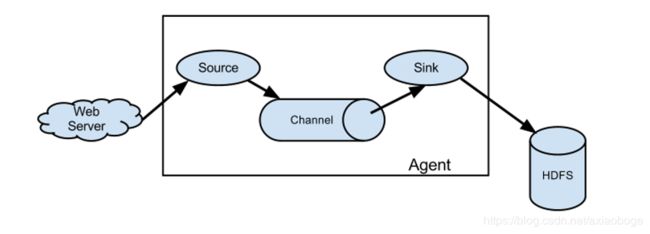Flume从入门到上手
第 1 章 Flume 概述
1.1 Flume 定义 :
Flume 是 Cloudera 提供的一个高可用的,高可靠的,分布式的海量日志采集、聚合和传输的系统。Flume 基于流式架构,灵活简单。
1.2 Flume架构
1.2.1 Agent
Agent 是一个 JVM 进程,它以事件的形式将数据从源头送至目的。
Agent 主要有 3 个部分组成,Source、Channel、Sink。
1.2.2 Source
Source 是负责接收数据到 Flume Agent 的组件。Source 组件可以处理各种类型、各种
格式的日志数据,包括 avro、thrift、exec、jms、spooling directory、netcat、sequence
generator、syslog、http、legacy。
1.2.3 Sink
Sink 不断地轮询 Channel 中的事件且批量地移除它们,并将这些事件批量写入到存储
或索引系统、或者被发送到另一个 Flume Agent。Sink 组件目的地包括 hdfs、logger、avro、thrift、ipc、file、HBase、 solr、自定义。
1.2.4 Channel
Channel 是位于 Source 和 Sink 之间的缓冲区。因此,Channel 允许 Source 和 Sink 运
作在不同的速率上。Channel 是线程安全的,可以同时处理几个 Source 的写入操作和几个
Sink 的读取操作。
Flume 自带两种 Channel:Memory Channel 和 File Channel 以及 Kafka Channel。
Memory Channel 是内存中的队列。Memory Channel 在不需要关心数据丢失的情景下适
用。如果需要关心数据丢失,那么 Memory Channel 就不应该使用,因为程序死亡、机器宕
机或者重启都会导致数据丢失。
File Channel 将所有事件写到磁盘。因此在程序关闭或机器宕机的情况下不会丢失数
据。
1.2.5 Event
传输单元,Flume 数据传输的基本单元,以 Event 的形式将数据从源头送至目的地。
Event 由 Header 和 Body 两部分组成,Header 用来存放该 event 的一些属性,为 K-V 结构,
Body 用来存放该条数据,形式为字节数组。
第 2 章 Flume 安装与部署
2.1 Flume官网 可以看看,文档写的简单明了
官网 :flume.apache.org 用户文档 版本1.8 : http://flume.apache.org/releases/content/1.8.0/FlumeUserGuide.html
2.2 下载安装
linux上直接使用 wget http://archive.apache.org/dist/flume/1.8.0/apache-flume-1.8.0-bin.tar.gz 下载,解压,安装
基本不用配置,jdk必须要1.8+,其他内存,磁盘,文件权限都应该没啥问题,遇到问题自行修改就好了.
第一步 :解压:tar -zxvf apache-flume-1.8.0-bin.tar.gz
第二步: 重命名 :mv apache-flume-1.8.0-bin flume-1.8.0
3.Flume入门例子
3.1 使用Flume监听本地一个端口,收集端口输入的数据,打印到控制台
我们进入Flume的conf目录下,编辑一个配置文件,自定命名 example1.conf
# example.conf: A single-node Flume configuration
# Name the components on this agent
a1代表agent,一个agent由source,channel,sink组成
a1.sources = r1 #source的名称
a1.sinks = k1 #sink的名称
a1.channels = c1 #channel的名称
# Describe/configure the source 配置source组件
a1.sources.r1.type = netcat #source类型
a1.sources.r1.bind = 192.168.1.4 #绑定的ip
a1.sources.r1.port = 16888 #绑定的端口
# Describe the sink 配置sink组件
a1.sinks.k1.type = logger #输出日志是到控制台
# Use a channel which buffers events in memory #配置channel管道,使用的是内存
a1.channels.c1.type = memory #管道收集数据的类型
a1.channels.c1.capacity = 1000 #管道容量大小,一个代表一个event
a1.channels.c1.transactionCapacity = 100 #表示收到100Event再去提交事务
#配置完需要把流程组件绑定起来,就是告诉source收集的数据给谁,sink找谁要数据
# Bind the source and sink to the channel
a1.sources.r1.channels = c1
a1.sinks.k1.channel = c1配置完成后,我们保存退出,然后启动一个本地端口.
我们先检测本地有没有要启动端口
检查端口并没哟被使用.然后我们启动一个本地端口
很明显,我们没有安装nc组件
yum install nc 安装一下,不是root用户需要授权一下
bin/flume-ng agent --conf conf/ --conf-file example1.conf --name a1 -Dflume.root.logger=INFO,console参数说明:
--conf :表示配置文件存储在 conf/目录
--name:表示给 agent 起名为 a1
--conf-file:flume 本次启动读取的配置文件是在 conf文件夹下的example1.conf文件。
-Dflume.root.logger=INFO,console :-D 表示 flume 运行时动态修改 flume.root.logger
参数属性值,并将控制台日志打印级别设置为 INFO 级别。日志级别包括:log、info、warn、
error。
然后我们输入数据
至此,我们第一个例子完成了。
3.2 监控一个文本,实时监测动态发生的数据变化
我们到Flume的conf下,复制一个conf,命名为example2.log
# example.conf: A single-node Flume configuration
# Name the components on this agent
a1.sources = r1
a1.sinks = k1
a1.channels = c1
# Describe/configure the source 只修改这个source
a1.sources.r1.type = exec #(Exec source在启动时运行一个给定的Unix命令,并期望该进程在标准输出上不断地生成数据(除非将属性logStdErr设置为true,否则将直接丢弃stderr)。如果进程出于任何原因退出,源也将退出,并且不会产生进一步的数据。这意味着像cat [named pipe]或tail - f [file]这样的配置将产生预期的结果,而as date可能不会产生这种结果——前两个命令将产生数据流,而后者将产生单个事件并退出。)
a1.sources.r1.command = tail -F /usr/local/dynamic.log #动态查看一个文本
# Describe the sink
a1.sinks.k1.type = logger
# Use a channel which buffers events in memory
a1.channels.c1.type = memory
a1.channels.c1.capacity = 1000
a1.channels.c1.transactionCapacity = 100
# Bind the source and sink to the channel
a1.sources.r1.channels = c1
a1.sinks.k1.channel = c1
其他的配置不动,然后我们启动Flume,上次的Flume已经被我kill掉了,
没有kill 的 ,使用 jps -ml监测flume进程 然后kill
在我们指定的路径下创建文件,然后写入数据
至此,入门案列结束.







